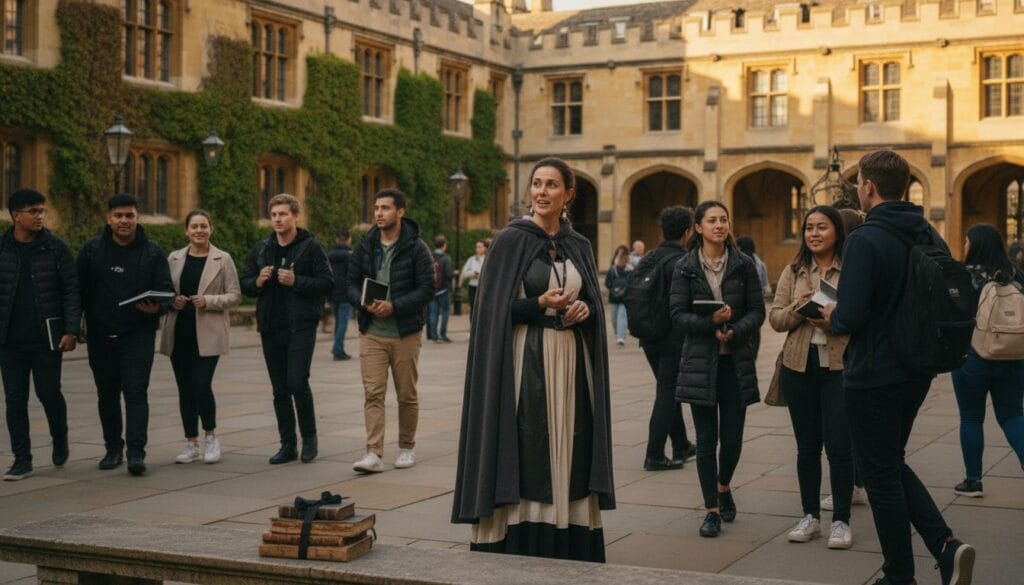Over 750 years of continuous academic tradition set Oxford’s oldest colleges apart in the british educational landscape. These ancient institutions are more than beautiful stone buildings, they have shaped generations of thinkers and defined what it means to pursue knowledge at the highest level. If you are curious about where british intellectual traditions began, exploring Oxford’s oldest colleges reveals a world where history, culture, and learning still thrive today.
Table of Contents
- Defining Oxford’s Oldest Colleges
- Chronology Of The Earliest Foundations
- Historic Roles And Academic Traditions
- Architectural Highlights And Notable Alumni
- Visiting Tips And Harry Potter Filming Locations
Key Takeaways
| Point | Details |
|---|---|
| Oldest colleges established in the 13th and 14th centuries | Oxford’s oldest colleges, such as University College and Balliol College, laid the groundwork for modern academic traditions. |
| Significance of architectural heritage | The colleges exemplify medieval architectural craftsmanship, blending historical significance with academic legacy. |
| Role in academic excellence | These institutions foster rigorous scholarship, mentorship, and knowledge exchange, shaping global leaders and intellectual discourse. |
| Visitor engagement and film history | Oxford’s colleges provide unique insights into both academic heritage and their role as filming locations for the Harry Potter series. |
Defining Oxford’s Oldest Colleges
Oxford University’s collegiate system represents a unique historical academic landscape where some colleges have stood for centuries, preserving remarkable traditions of scholarship and intellectual development. Oldest colleges at Oxford are not merely buildings but living institutions that have shaped academic excellence since medieval times.
The definition of an “oldest college” at Oxford requires understanding specific historical criteria. Generally, the oldest colleges date back to the 13th and 14th centuries, with University College being considered the first established in 1249. These ancient institutions were founded by scholars, religious orders, and wealthy patrons who sought to create permanent academic communities dedicated to learning and research.
Key Characteristics of Oxford’s Oldest Colleges
- Founded between 1249 and 1400
- Established with specific academic or religious purposes
- Retain original architectural elements
- Continuously operational for multiple centuries
- Maintained significant scholarly traditions
While determining the absolute “oldest” college can be complex, historians typically recognize several key institutions as foundational. Balliol College, established around 1263, stands as another critically important early college that exemplifies Oxford’s medieval academic heritage. These colleges were not just educational institutions but represented complex social ecosystems where learning, religious practice, and community intersected.
Visitors and scholars alike are drawn to these historic colleges, which continue to represent living museums of academic culture. Each stone, corridor, and quadrangle tells a story of intellectual pursuit spanning centuries, making Oxford’s oldest colleges far more than mere buildings – they are repositories of knowledge, tradition, and human aspiration.

Chronology Of The Earliest Foundations
The establishment of Oxford’s earliest colleges represents a pivotal moment in medieval academic history, marking the transition from informal learning spaces to structured institutional foundations. Ox.ac.uk provides definitive insight into this critical period, revealing that University College emerged as the first formal collegiate institution in 1249, setting a precedent for scholarly organization.
Key Early College Foundations
- University College (1249)
- Balliol College (1263)
- Merton College (1264)
According to Britannica, Merton College’s foundation in 1264 represented a crucial milestone in Oxford’s academic development. These early colleges were not merely physical spaces but intellectual ecosystems where scholars could live, study, and engage in rigorous academic discourse. They emerged during a transformative period when education was transitioning from monastic traditions to more secular, structured learning environments.
The chronology of these early foundations reveals a strategic and organic development of Oxford’s collegiate system. Each college brought unique characteristics – scholarly focuses, architectural designs, and philosophical approaches that would eventually shape the university’s global reputation.
![]() Religious orders, wealthy patrons, and forward-thinking academics collaborated to create these institutions, viewing them as more than educational establishments but as vital centers of knowledge preservation and intellectual innovation.
Religious orders, wealthy patrons, and forward-thinking academics collaborated to create these institutions, viewing them as more than educational establishments but as vital centers of knowledge preservation and intellectual innovation.
Interestingly, the proximity of these foundations – all established within 15 years of each other – suggests a remarkable period of academic entrepreneurship. Brasenose College would later join these pioneering institutions, further expanding Oxford’s collegiate landscape. These early colleges laid the groundwork for what would become one of the world’s most prestigious universities, transforming Oxford from a collection of independent scholars to a structured, internationally renowned center of learning.
Historic Roles And Academic Traditions
The oldest Oxford colleges represent far more than architectural monuments; they are living repositories of intellectual heritage and scholarly transformation. Ox.ac.uk highlights how these institutions have been central to academic excellence, providing structured environments that have nurtured generations of scholars, researchers, and global leaders.
Key Academic Traditions
- Rigorous scholarly inquiry
- Interdisciplinary research approaches
- Preservation of intellectual heritage
- Mentorship and academic community
- Continuous knowledge exchange
University College exemplifies the profound academic traditions that define Oxford’s collegiate system. Its historical commitment to intellectual exploration established a blueprint for scholarly engagement that would influence academic practices worldwide. These colleges were not merely educational institutions but intellectual ecosystems where knowledge was critically examined, challenged, and advanced.
The historic roles of these colleges extended beyond traditional academic boundaries. They functioned as microcosms of intellectual society, where scholars from diverse backgrounds could engage in profound discussions, challenge existing paradigms, and develop groundbreaking ideas. Religious scholars, philosophers, scientists, and social theorists found in these colleges a unique environment that encouraged critical thinking and collaborative research.
Moreover, these institutions played a crucial role in democratizing education. While initially accessible primarily to privileged classes, Oxford’s oldest colleges gradually became platforms for intellectual merit, regardless of social background. Explore Oxford’s Colleges reveals how these foundations transformed from exclusive scholarly retreats to inclusive centers of academic excellence, setting international standards for higher education and intellectual pursuit.
Architectural Highlights And Notable Alumni
Oxford’s oldest colleges stand as architectural masterpieces, blending medieval craftsmanship with historical significance that transcends mere physical structures. Merton College exemplifies this architectural brilliance, featuring medieval quadrangles that have witnessed centuries of scholarly evolution, with intricate stone work and design elements that tell stories of academic tradition.
Architectural Characteristics
- Medieval stone construction
- Intricate Gothic architectural elements
- Historical quadrangle designs
- Preserved original architectural features
- Blend of medieval and Victorian styles
Notable alumni have emerged from these remarkable institutions, transforming these architectural spaces into launching pads for global intellectual achievement. Balliol College represents this legacy perfectly, having nurtured distinguished figures like former UK Prime Minister Harold Macmillan and economist Adam Smith, whose groundbreaking work in economic theory originated within these historic walls.
The architectural narrative of these colleges extends beyond physical beauty. Merton College particularly stands out, having been home to legendary figures like J.R.R. Tolkien, the renowned author of ‘The Lord of the Rings’, and T.S. Eliot, a revolutionary poet and playwright. These spaces were more than educational institutions – they were crucibles of creativity where intellectual giants developed ideas that would reshape global culture.
Explore Oxford’s Colleges reveals how these architectural marvels continue to inspire contemporary scholars. Each stone, archway, and hall represents a living museum of academic excellence, where architectural heritage meets intellectual innovation. The oldest colleges demonstrate that true educational environments are not just about buildings, but about creating spaces that nurture extraordinary human potential.
Visiting Tips And Harry Potter Filming Locations
Ox.ac.uk provides essential guidance for exploring Oxford’s historic colleges, which serve as both academic landmarks and magical film locations. Visitors should plan carefully, as many colleges have specific visiting hours and entry requirements that can significantly impact their exploration of these iconic spaces.
Top Harry Potter Filming Locations
- Christ Church College Great Hall
- New College Cloisters
- Bodleian Library
- Divinity School
- Magdalen College Grounds
Step by Step Harry Potter Tour enthusiasts will be thrilled to discover that several Oxford colleges served as primary filming locations for the beloved Harry Potter film series. Christ Church College, in particular, inspired the Great Hall scenes at Hogwarts, with its magnificent architectural details capturing the magical essence of the wizarding world.
Navigating these historic locations requires strategic planning. Most colleges charge modest entry fees, and visitors should check individual websites for current visiting hours. Some locations require advance booking, especially during peak tourist seasons. The New College Cloisters, for instance, featured prominently in multiple Harry Potter scenes, offering fans an immersive experience of walking where movie magic was created.
Walking Tour Oxford provides an exceptional opportunity to explore these interconnected magical spaces. Each college tells a unique story, blending centuries of academic history with the enchantment of cinematic storytelling. Visitors should wear comfortable walking shoes, bring a camera, and prepare to be transported into a world where historic architecture and magical imagination seamlessly intertwine.
Discover the Magic of Oxford’s Oldest Colleges in a Unique Walking Tour Experience
Exploring the rich academic heritage and historic architecture of Oxford’s oldest colleges can feel overwhelming without expert guidance. You want to truly connect with the stories behind University College, Balliol College, and Merton College and experience where history and magic intertwine. Our walking tours uniquely solve this by bringing these colleges to life with live entertainment featuring a magician who has performed for the British Royal family and A-list celebrities. This adds an extraordinary layer of wonder to your journey through Oxford’s medieval quadrangles and Harry Potter filming locations.

Unlock the secrets of Oxford’s oldest colleges in a way no other tour offers. Step inside iconic locations like those featured in the Harry Potter films while enjoying storytelling and live magic that reveal hidden tales from centuries of academic tradition. Don’t just visit history — immerse yourself in it today by booking your place on the Oxford Magic Tours walking tour. Check out our guides on exploring Oxford’s colleges and join the step-by-step Harry Potter tour to capture every magic-lit moment.
Frequently Asked Questions
What are the oldest colleges at Oxford University?
The oldest colleges at Oxford University include University College, established in 1249, Balliol College, founded around 1263, and Merton College, which was established in 1264.
What key characteristics define Oxford’s oldest colleges?
Oxford’s oldest colleges are typically characterised by their founding dates between 1249 and 1400, their original architectural elements, and their continuous operational status over several centuries.
How have Oxford’s oldest colleges contributed to academic traditions?
These colleges have been central to academic excellence, promoting rigorous scholarly inquiry, interdisciplinary research, and preserving intellectual heritage, thus shaping generations of scholars and leaders.
Can visitors explore Oxford’s oldest colleges?
Yes, visitors can explore Oxford’s oldest colleges, although entry requirements and visiting hours may vary. Many colleges also feature notable sites from the Harry Potter films, adding to their allure as tourist destinations.
